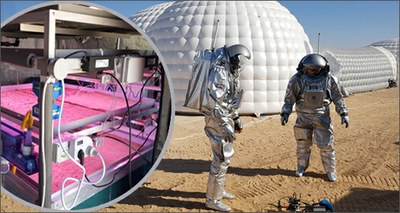Space: A proving ground for a potential future veg garden on Mars
22/2/2018
The mission Amadee-18 has officially started in Oman, in the Arabian Peninsula, with a simulation of Mars landing and the beginning of the isolation phase. Until February 28, five “would-be astronauts”, will conduct experiments simulating the conditions of the Red Planet with the objective of testing tools and procedures for future space missions.
 Italy will feed the future crew members with fresh food supplied by a hyper-technological vegetable garden, developed by ENEA, ASI (Italian Space Agency) and the Milan University, as part of the project “HortExtreme”.
Italy will feed the future crew members with fresh food supplied by a hyper-technological vegetable garden, developed by ENEA, ASI (Italian Space Agency) and the Milan University, as part of the project “HortExtreme”.
Thanks to an advanced sensoristic network, the Italian researchers will coordinate and monitor the experimental activities from the ENEA Casaccia Research Center until the end of the mission, directly connected with the station.
For the mission Amadee-18, coordinated by the Austrian Space Forum, the researchers have organized an inflatable tent accomodating a plant growth chamber and a prototype of containment system for plant biology experiments.
Once the preliminary phase of the mission–necessary to provide logistic and scientific support to the start of the trial- was over, researchers Luca Nardi (ENEA), Sara Piccirillo (ASI) e Francesco Cavaliere (Milan University), left the “Kepler Station”, the field base in the Dhofar desert in Oman, where the analog astronauts who will carry out the experiments, have started the isolation phase.
The experiments on the Italian-made vegetable garden will be useful to verify the feasibility of the facility, assess its energy consumption, estimate its productivity and select the varieties of plants which can adjust to extreme environmental conditions both on earth, like Antarctica, and on distant planets like Mars.
With the installation of four sectors dedicated to germination and growth, the researchers have completed the vertical, soilless, hydroponic tower, the so called “Martian garden”, a 4 m2 containment system in which four types of red microgreens-including red cabbage and radishes-appropriately selected because of their short vital cycle (fifteen days), are grown.
Thanks to Led lights and recirculated water, the microvegetables, free of pesticides and agrochemicals, will ensure a correct nutritional intake and high quality food to crew members.
“The indoor technological infrastructure will make it possible to monitor plants growth in every phase and work as remote control in the case of problems during the mission, with a time delay of approximately 20 minutes between the brodcast signal and the response time, just like if the austronauts were on Martian ground”, Luca Nardi at ENEA, pointed out.
“Setting up the growing chamber is a delicate stage, crucial for starting the experiment properly. It enables us to verify the accuracy of the first sowing and, through an advanced sensoristic network, to monitor the environmental conditions to which the four plants will be exposed in the prototype”, Sara Piccirillo of ASI, added.
“The inflatable stucture is composed of eight tubulars with a 35 cm- diameter and a central beam with the same diameter. The modules were assembled adopting techniques aimed at avoiding a pressure increase due to solar radiation. We’ve also installed a sheet allowing a constant air flow, 6 stabilizers which make the tent rigid and resistant to strong winds and 8 windows which allow both the entrance of the cables and the exit of the sensors, for acquiring the different parameters of the experiment”, Francesco Cavaliere of the University of Milan, concluded.
Like the astronauts of future missions on the Red Planet, the crew memebers, during their isolation phase in Oman, will follow a diet based almost exclusively on canned food, which they can integrate with the micro-vegetables grown during the experiment, properly selected because of their capability of accumulating significant amounts of minerals and phytonutrients like vitamins, carotinoids and flavonoids, including anthocyanins, molecules with a high antioxidant power, with a beneficial antistress effect.
For more information please contact:
Luca Nardi, ENEA – Laboratory of Biotechnologies, luca.nardi@enea.it
